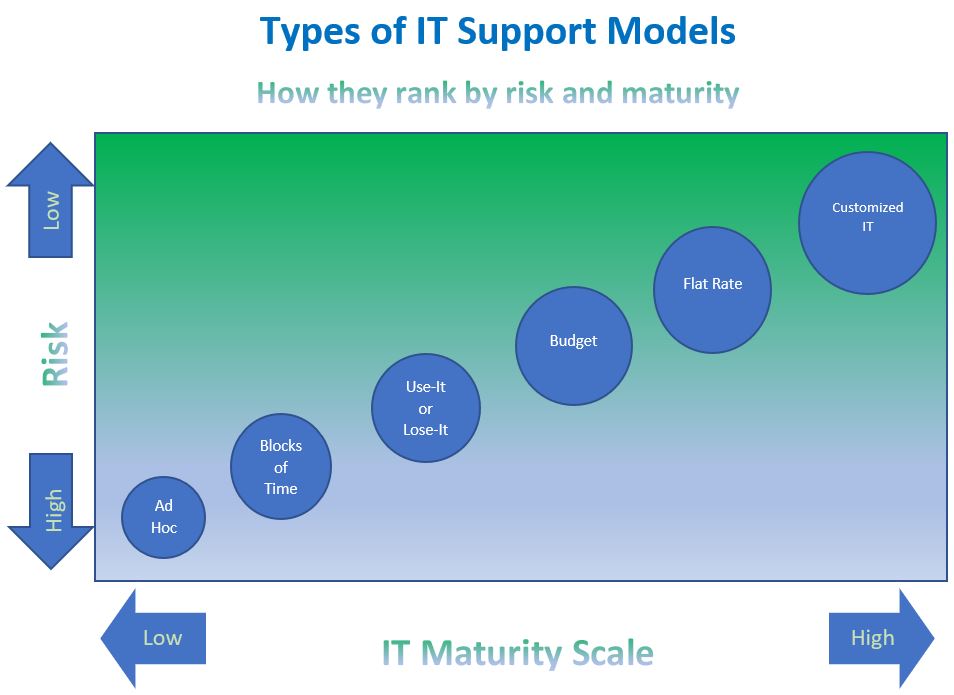Support Models at a Glance
Know how to compare IT support companies. This article summarizes the INSI Types of IT Support Models Series based on the book: IT Outsourcing Secrets. Previously, we took a closer look at Ad Hoc, Blocks of Time, Use-it-Or-Lose-It, Budget, and Flat Rate programs. However, in this article, we are going to step back and view the models holistically. Further, we are going to explain how the Customized IT Support Program addresses the flaws you see in the IT support landscape.
High Level IT Support Model Comparison

It is important to look at two things when comparing IT support models: Risk and IT Maturity.
- Risk is based on the overall cost
- IT Maturity Scale is based on the efficiencies of the organization
The two must be combined to help determine which model is best for you. See below:
Ad Hoc is High Risk and Low on the IT Maturity Scale:
An independent contractor who sells Ad Hoc services does not usually charge that much because he/she does not have much overhead. In addition, they haven’t invested in people, processes, or technology to perform proper documentation, track your assets issues, and monitor.
In other words, they lack efficiencies. This often results in multiple visits, multiple breaks, and security risks which cause the cost to spiral out of control.
Blocks of Time is High Risk and Low on the IT Maturity Scale:
These companies usually have a handful of IT people and technology tools to provide a certain level of efficiency. However, the risk is high because of the liability on the unused hours. Therefore, they cannot staff appropriately because they do not know when the hours will be called in by the client.
Further, the business does go on as usual and expenses must be paid. So, by the time the client calls in the hours, they may not have to respond to the client’s needs. Without a doubt, this is a high risk for the client and the IT support provider.
Use-it-Or-Lose-it is High Risk and Medium on the IT Maturity Scale:
Use-it-Or-Lose-it firms usually invest in people, processes, and technology, but the cost burden is still heavily placed on the client. Hence, if the client does not use all their hours for the month they lose it. If they go over their hours they pay a hefty overage fee.
Budget is High Risk and High on the IT Maturity Scale:
Budget IT support companies do invest highly in processes, people, and technology. However, the cost risk is extremely high to the client and the invoices are highly unpredictable.
Fixed-Rate is Low Risk and Medium to High on the IT Maturity Scale:
Also known as price per seat or price per device, Fixed Rate companies absorb all the cost on devices that are under contract. This makes the risk extremely low. In addition, they need to invest in people, processes, and technology to run efficiently and make a profit.
However, not all Fixed Rate companies are equal and you must ask the right questions to know where they are on the IT maturity scale. Further, the client is paying the same high rates for entry-level tickets as they are for advanced support issues.
INSI Customized IT™ Low on Risk and High on IT Maturity
The INSI Customized IT™ support program absorbs all the cost with a monthly flat rate, lowers the cost on 80% of the IT support cost, and invests heavily in people, processes, and technology.
The INSI Customized IT™ plan was designed with the other IT support plans in mind. It addresses the flaws within the IT support industry and offers real solutions.
How Does Customized IT Compare to Other IT Support Models?
There are several advantages to the INSI Customized IT™ program, including:
- Low-Risk Flat Fee – INSI will absorb all the risk on their INSI Customized IT™ and Managed Support programs with a fixed monthly fee.
- Delivers Better Quality – INSI’s tiered support structure ensures our clients are receiving the right level of support for each issue they call in. As an example, Tier 3 engineers are only assigned Tier 3 tickets. For this reason, they are much better at solving the client’s advanced issues. Further, our entry-level engineers are only assigned entry-level tickets. Therefore, they do not find themselves in over their head and learning on the client’s time.
- One Back to Pat – The initial engineer takes complete ownership of the ticket. If they do not know how to resolve the ticket within 15 minutes, a higher level engineer will fix the problem in front of them. As a result, this speeds up the time to resolution for the client, while also increasing the skill set of the engineer. Subsequently, the next time your engineer gets the same issue, they will know how to resolve it.
- Lowers 80% of the IT Support Cost – All INSI support programs incorporate true helpdesk rates on tiers 1 & 2. Consequently, this lowers the cost of 80% of the tickets to entry-level rates.
- Right-Sized for the Client – Since each service is broken out into its own service, the client can pick and choose the exact services they want in their IT support program. Now that’s true customization!
Do You Want To Learn More About the Different Types of IT Support Models?
Go here to see the various types of IT support, their pros and cons, and great questions to ask the provider on each one.
In addition, if you would like to know more about this topic and how it affects you, visit Amazon or Barnes & Noble for a copy of the book IT Outsourcing Secrets – A Small Business Guide to Comparing IT Support Companies.

